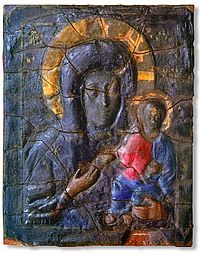860 року був набіг русів на Царьград, коли Візантія воювала з арабами і не було військ в столиці.
Відповідно там були всякі легенди, про святу ікону що перед нею візантійці молилися за спасіння своєї столиці.
Так от в 17 століттю цю ікону скомунізділи-привезли в Москву і позиціонували як ікону що врятувала Царьград від орди варварів.
І взагалі ця історія була свого часу широко представлена в московських іконах.
Так що історична шизофренія в Росії тягнеться століттями

The sermons of Photius offer no clue as to the outcome of the invasion or the reasons why the Rus' withdrew to their own country. Later sources attribute their retreat to the Emperor's speedy return to the capital. As the story goes, after Michael and Photius put the veil of the Theotokos into the sea, there arose a tempest which dispersed the boats of the barbarians. In later centuries, it was said that the Emperor hurried to the church at Blachernae and had the robe of the Theotokos carried in procession along the Theodosian Walls. This precious Byzantine relic was dipped symbolically into the sea and a great wind immediately arose and wrecked the Rus' ships.[1] The pious legend was recorded by George Hamartolus, whose manuscript was an important source for the Primary Chronicle.[8] The authors of the Kievan chronicle appended the names of Askold and Dir to the account as they believed that these two Varangians had presided over Kiev in 866. It was to this year that (through some quirk in chronology) they attributed the first Rus' expedition against the Byzantine capital.[9]
The Blachernitissa: the icon before which Michael III may have prayed to the Theotokos for the deliverance of Constantinople from the Rus'.
Nestor's account of the first encounter between the Rus' and the Byzantines may have contributed to the popularity of the Theotokos in Russia. The miraculous saving of Constantinople from the barbarian hordes would appear in Russian icon-painting, without understanding that the hordes in question may have issued from Kiev. Furthermore, when the Blachernitissa was brought to Moscow in the 17th century, it was said that it was this icon that had saved Tsargrad from the troops of the "Scythian khagan", after Michael III had prayed before it to the Theotokos. Nobody noticed that the story had obvious parallels with the sequence of events described by Nestor.
In the 9th century, a legend sprang up to the effect that an ancient column at the Forum of Taurus had an inscription predicting that Constantinople would be conquered by the Rus. This legend, well known in Byzantine literature, was revived by the Slavophiles in the 19th century, when Russia was on the point of wresting the city from the Ottomans.